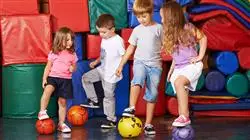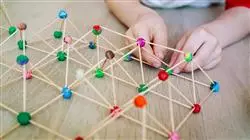University certificate
The world's largest faculty of education”
Introduction to the Program
Learn to develop your students' fine and general motor skills thanks to the expert skills you will acquire from this highly impactful, high quality Professional master’s degree"

Activities aimed at promoting the development of motor skills require educators who have an extensive and up to date knowledge of the field, these tasks will allow them to plan and apply strategies, dynamics and techniques aimed at improving psychomotor skills
This Professional master’s degree in Child Psychomotricity for Teachers has compiled the most interesting theoretical and practical knowledge for teachers of this stage of the educational process, so that it can be applied to the early childhood classroom, and they can benefit from a unique opportunity for professional growth.
This program is unique due to the fact that it can be taken in a 100% online format which is fully adaptable to the needs and obligations of any student as they themselves can self-manage their time to suit their own personal circumstances. Students will be able to choose on which days, at what time and how long to dedicate to their study of the contents of the program.
The design and structure of the subjects and the units have been specifically designed to allow each student to choose their own schedule and self-manage their time. For this purpose, they will have access to theoretical materials presented through enriching texts, multimedia presentations, exercises and guided practical activities alongside motivational videos, master classes and case studies. From these they will be able to extract knowledge in an organized manner and improve their decision-making skills - a factor which will demonstrate their high-level of qualification within this area of teaching.
A highly educational learning process aimed at those students who wish to surround themselves with the best and excel in their profession, not only to achieve their own personal goals, but principally to make a difference to the general education of their students.
Contextual learning, supported by a multitude of practical cases which will enable you can to learn from authentic, true-to-life case studies"
This Professional master’s degree in Child Psychomotricity for Teachers contains the most complete and up-to-date educational program on the market. The most important features include:
- Practical cases presented in simulated scenarios by experts in the field of study, where the student will evoke in an orderly manner the knowledge learned and demonstrate the acquisition of the competencies
- The graphic, schematic, and practical contents with which they are created, provide scientific and practical information on the disciplines that are essential for professional practice
- The latest news on the educational task of the early childhood education teacher
- Practical exercises where the students undergo the self-assessment process to improve learning, as well as activities at different skill levels
- Special emphasis on innovative methodologies and teaching research
- Theoretical lessons, questions to the expert, debate forums on controversial topics, and individual reflection assignments
- Content that is accessible from any fixed or portable device with an Internet connection
Immerse yourself in this complete program, in which you will find everything you need to improve professionally and compete with the best"
TECH includes, in its teaching staff, professionals belonging to the field of teacher training, who contribute to this education their vast work experience, as well as leading specialists from prestigious societies and universities.
The multimedia content, developed with the latest educational technology, will provide the professional with situated and contextual learning, i.e., a simulated environment that will provide immersive learning programmed to train in real situations.
This program is designed around Problem-Based Learning, whereby the professional must try to solve the different professional practice situations that arise throughout the program. For this purpose, the teacher will be assisted by an innovative interactive video system created by leading experts in the field of job preparation and orientation with extensive teaching experience.
We offer you the best teaching methodology with a multitude of practical cases so that you can develop yourself professionally as if you were facing real cases"

The program gives students the opportunity to learn and grow as teachers, empowering them with educational tools and strategies which can be directly applied to the needs of their classrooms"
Why study at TECH?
TECH is the world’s largest online university. With an impressive catalog of more than 14,000 university programs available in 11 languages, it is positioned as a leader in employability, with a 99% job placement rate. In addition, it relies on an enormous faculty of more than 6,000 professors of the highest international renown.

Study at the world's largest online university and guarantee your professional success. The future starts at TECH”
The world’s best online university according to FORBES
The prestigious Forbes magazine, specialized in business and finance, has highlighted TECH as “the world's best online university” This is what they have recently stated in an article in their digital edition in which they echo the success story of this institution, “thanks to the academic offer it provides, the selection of its teaching staff, and an innovative learning method aimed at educating the professionals of the future”
A revolutionary study method, a cutting-edge faculty and a practical focus: the key to TECH's success.
The most complete study plans on the university scene
TECH offers the most complete study plans on the university scene, with syllabuses that cover fundamental concepts and, at the same time, the main scientific advances in their specific scientific areas. In addition, these programs are continuously being updated to guarantee students the academic vanguard and the most in-demand professional skills. In this way, the university's qualifications provide its graduates with a significant advantage to propel their careers to success.
TECH offers the most comprehensive and intensive study plans on the current university scene.
A world-class teaching staff
TECH's teaching staff is made up of more than 6,000 professors with the highest international recognition. Professors, researchers and top executives of multinational companies, including Isaiah Covington, performance coach of the Boston Celtics; Magda Romanska, principal investigator at Harvard MetaLAB; Ignacio Wistumba, chairman of the department of translational molecular pathology at MD Anderson Cancer Center; and D.W. Pine, creative director of TIME magazine, among others.
Internationally renowned experts, specialized in different branches of Health, Technology, Communication and Business, form part of the TECH faculty.
A unique learning method
TECH is the first university to use Relearning in all its programs. It is the best online learning methodology, accredited with international teaching quality certifications, provided by prestigious educational agencies. In addition, this disruptive educational model is complemented with the “Case Method”, thereby setting up a unique online teaching strategy. Innovative teaching resources are also implemented, including detailed videos, infographics and interactive summaries.
TECH combines Relearning and the Case Method in all its university programs to guarantee excellent theoretical and practical learning, studying whenever and wherever you want.
The world's largest online university
TECH is the world’s largest online university. We are the largest educational institution, with the best and widest online educational catalog, one hundred percent online and covering the vast majority of areas of knowledge. We offer a large selection of our own degrees and accredited online undergraduate and postgraduate degrees. In total, more than 14,000 university degrees, in eleven different languages, make us the largest educational largest in the world.
TECH has the world's most extensive catalog of academic and official programs, available in more than 11 languages.
Google Premier Partner
The American technology giant has awarded TECH the Google Google Premier Partner badge. This award, which is only available to 3% of the world's companies, highlights the efficient, flexible and tailored experience that this university provides to students. The recognition as a Google Premier Partner not only accredits the maximum rigor, performance and investment in TECH's digital infrastructures, but also places this university as one of the world's leading technology companies.
Google has positioned TECH in the top 3% of the world's most important technology companies by awarding it its Google Premier Partner badge.
The official online university of the NBA
TECH is the official online university of the NBA. Thanks to our agreement with the biggest league in basketball, we offer our students exclusive university programs, as well as a wide variety of educational resources focused on the business of the league and other areas of the sports industry. Each program is made up of a uniquely designed syllabus and features exceptional guest hosts: professionals with a distinguished sports background who will offer their expertise on the most relevant topics.
TECH has been selected by the NBA, the world's top basketball league, as its official online university.
The top-rated university by its students
Students have positioned TECH as the world's top-rated university on the main review websites, with a highest rating of 4.9 out of 5, obtained from more than 1,000 reviews. These results consolidate TECH as the benchmark university institution at an international level, reflecting the excellence and positive impact of its educational model.” reflecting the excellence and positive impact of its educational model.”
TECH is the world’s top-rated university by its students.
Leaders in employability
TECH has managed to become the leading university in employability. 99% of its students obtain jobs in the academic field they have studied, within one year of completing any of the university's programs. A similar number achieve immediate career enhancement. All this thanks to a study methodology that bases its effectiveness on the acquisition of practical skills, which are absolutely necessary for professional development.
99% of TECH graduates find a job within a year of completing their studies.
Professional Master's Degree in Child Psychomotricity
In the field of child development, psychomotor skills play a fundamental role. If you are looking to delve into this fascinating field and become a highly trained professional, the Professional Master's Degree in Child Psychomotricity created by TECH Global University is the ideal option for you. In this postgraduate course you will find the best educational tools of the moment, which will turn you into a highly prestigious expert. Here, we have the best online methodology, through which you can combine your learning with other personal or work activities. The program focuses on the study of the relationship between the body, movement and the cognitive, emotional and social development of children. Through a combination of theory and practice, you will learn to use specialized techniques and tools to promote psychomotor development at an early age. In addition, you will gain the necessary skills to understand and enhance the integral development of children.
Specialize in child psychomotor development
This innovative program, created by TECH's top specialists, covers a wide range of topics ranging from neuroscience applied to psychomotor skills, to therapeutic and educational intervention in clinical and school contexts. In addition, you will become familiar with different psychomotor approaches and learn how to adapt your interventions to the individual needs of each child. At the end of the program, you will be prepared to work as a psychomotor therapist in a variety of settings, such as clinics, hospitals, educational centers and early intervention programs. You will be able to design and develop psychomotor stimulation sessions, evaluate children's progress and work in collaboration with other professionals to offer a comprehensive and personalized approach.







